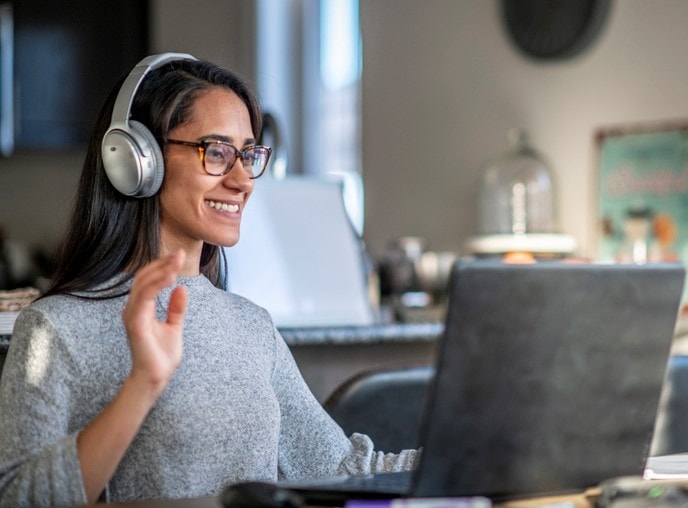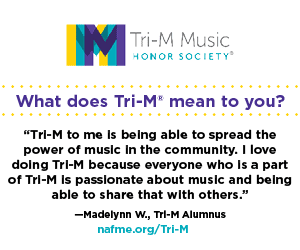/ News Posts / 5 Strategies for Optimal Zoom Room Engagement
5 Strategies for Optimal Zoom Room Engagement
By NAfME Members Angela Ammerman and Jacob Kohut
Since the beginning of the incorporation of music as a course of study in U.S. schools, music has been taught IN the schools. This may seem like a given, however, in recent months, music IN the schools has no longer been an option for many music teachers across the U.S. In fact, the entire paradigm of a school system has shifted and may be changed forevermore.
In the spring of 2020, the entire world was impacted by the threat of the highly contagious and deadly Coronavirus. In order to slow the spread, nearly every school system in the United States shifted (for at least some period of time) from delivering instruction in-person to teaching online. Since that time, schools across the country have adopted a variety of options for course delivery from 100% online to hybrid to fully in-person. Regardless of the vehicle, teachers across the globe gained a greater awareness of and appreciation for teaching in an online setting.
The ensuing response to a global crisis resulted in massive confusion, series of transitions and delivery options for school families, and a variety of new methods for instruction. In this new age of instruction, many teachers have struggled with student participation, student buy-in, and behavior management. Classroom management is difficult enough with a room full of students with noisemakers, but the challenges of management is suddenly multiplied when we place those same musicians in separate spaces with a microphone, a camera, and no supervising adult in the room.

Managing one’s “Zoom Room” may look different for every music teacher. Ensemble directors are most certainly missing the opportunity to direct, in real-time, a group of student musicians, but making the virtual musical experience successful is still possible.
Ensemble Strategies
Students can use a variety of recording apps and programs not only to record their part, but they can even record the parts of their classmates. Programs like soundtrap, accapella, and audacity allow anyone to create layers of sound. Musicians who take advantage of these programs could eventually record all of the parts for a piece of music on their instrument and could have their own “Individual Ensemble.” Students can also partner with friends and classmates to layer one another’s recordings together.
Virtual Ensembles
Virtual Ensembles with split screen videos have become very trendy with music programs across America. To produce them, teachers either spent hours learning the software or spent a lot of money hiring videographers who could make amazing but costly videos. Fortunately using free software and teaching students how to do some of this work, basic versions of these videos are possible with less work on the teacher and no cost to the students or the program. Below is a chart for how to do a low-budget virtual ensemble with a link to a tutorial:
| Steps: | Details: |
| 1. Adjust Mic Levels |
|
| 2. Pick Lit One Level Under |
|
| 3. Teach Piece by Section |
|
| 4. Establish Metronome Fluency |
|
| 5. Sound Off |
|
| 6. Allow for Retakes |
|
| 7. Quad Videos |
|
| 8. Final Edit |
|
For a more in-depth and visual lesson on virtual ensembles, click HERE.
Motivation through Social Identity
In addition to uncovering new musical activities for students who may be in a virtual setting, teachers have also developed new ways to motivate their students through building social identity. In the past, building a sense of community occurred naturally because students were physically around one another, making music together, and interacting frequently. In a virtual world where students may not have actually seen one another in half a year, this may look completely different.
Although socializing may not seem to be an obvious learning objective, it is still something that every teacher should value. A positive social identity in a musical ensemble may increase student success and self-efficacy, and lead to increased retention.

See below for a few ways to build social identity online:
- Offer a themed day once a week to encourage students to have their cameras on and to provide a sense of group solidarity.
- Consider partner assignments so students get the opportunity to work together even if it is virtual.
- Create a custom logo for your music program and be sure to include it on everything.
-
- BONUS – Create a rewards system where you send “stickers” with your logo
- I use the app “Over” to create my own “Ammerbucks” and even my college students seem to love it!

Engagement, Engagement, Engagement!
Great classroom management has little to do with the classroom and everything to do with the engagement. Well-planned and well-paced lessons that meet students where they are have always been the bread and butter of good teaching inside and outside the music classroom.
That applies online too. Students who are bored online probably would have been bored in the classroom, just without the ability to open a new tab. Consider some of the options below for reaching optimal engagement virtually:
- Create a KAHOOT! (even my college students love this!)
- “Say My Name” Challenge – Try to say every student’s name at least once every week!
- Group Work – Encourage students to participate in groups at least once a week
- Create a Word Cloud of Practice Tips with Poll Everywhere
Pacing has always been a significant determinant for student behavior and engagement. For those teaching on the 80-90 minute block class system, what was a long class in person just became a marathon online. The amount of time spent on each activity can either reel your students in, or if class is moving too slowly, students may become bored and may even act out in order to get attention. Below is a well-paced sample schedule including an opportunity for teacher-student connection, student-student connection, a brain break, plenty of playing, and time for teaching new material. When it comes to warm-ups and fundamentals, the beginning of the year might be spent developing these routines during the concept portion.
Classroom Lesson Plan Examples: 80 Minutes
| Time | Activity | Comments |
| 3 minutes | Greeting | Share what’s going on in your day |
| 3-7 minutes | Small Groups | This can be random or by instrument section. Depending on technology have kids meet by section to socialize. It’s better if it’s not about music. |
| 8-10 minutes | Warm-Up | They’re muted and playing along with me |
| 8-10 minutes | Fundamentals | They’re muted and playing along with me |
| 15 minutes | Concept and Independent Work | Scales, Rhythms, new music or technology |
| 5 minutes | Break | Students can ask questions or take a break |
| 20-25 minutes | Music | Band music or chamber music |
| 5-10 minutes | Music Games | There are some great games out there online that are educational and can be used as an assessment grade: musicracer.com |
| 5 minutes | Exit Ticket Survey | A Google Form to find out what the kids thought of class, the flow, the amount of talking, playing, activities. |
Classroom Lesson Plan Examples: 45 Minutes
| Time | Activity | Comments |
| 3 minutes | Greeting | Share what’s going on in your day |
| 4-5 minutes | Warm-Up | They’re muted and playing along with me |
| 4-5 minutes | Fundamentals | They’re muted and playing along with me |
| 10 minutes | Concept | Scales, Rhythms, new music or technology |
| 15 minutes | Music | Band music or chamber music |
| 4-5 minutes | Music Games | There are some great games out there online that are educational and can be used as an assessment grade: musicracer.com |
| 3 minutes | Exit Ticket Survey | A Google Form to find out what the kids thought of class, the flow, the amount of talking, playing, activities. |
Whether you are seeing your students in a real classroom or on Blackboard, managing behaviors is all about pacing, engagement, motivation, and rapport. Work to keep a moderate to fast pace in which students are all fully engaged. Keep transition times as short as possible, and work to ensure that each student is engaged throughout your entire classes. Find ways to motivate your students so that they continue to enjoy music even in this different vehicle. Remember that we all have a job because there are students who want to take our classes. Maintain strong relationships with all of your students by ensuring that every member of your ensemble is “seen” regularly, encouraging the development of a unique culture within your class, and fostering strong connections between students. Music is often our students’ “home” within the school where students feel safe, they feel that they belong, and they feel that they matter. Although many of us are not seeing our students in real-time and in real-life, we must continue to find ways to manage our students and to foster positivity and social belonging within and around our classes.
About the authors:
 NAfME member Angela Ammerman, referred to by the Washington Post as the first “music teacher prodigy,” earned degrees from the Cincinnati College-Conservatory of Music, Boston University, and her PhD from George Mason University. Featured in the Tennessee Alumnus Magazine in 2019 for founding a strings program for orphaned children in Thailand, Dr. Ammerman has dedicated much of her musical career to providing access to quality music education for underserved populations of children. Recognized by Fairfax County Public Schools as the Top Teacher in 2017 and the Virginia House of Delegates in 2016 for her dedication to instilling a life-long passion for music in all of her students, Angela Ammerman diligently works to now pass along these teaching and mentorship qualities to her own students. Dr. Ammerman currently works with music education majors at George Mason University, James Madison University, and Roosevelt University. Ammerman lives in Virginia with her husband and her new baby, David Michael. Learn more about Angela.
NAfME member Angela Ammerman, referred to by the Washington Post as the first “music teacher prodigy,” earned degrees from the Cincinnati College-Conservatory of Music, Boston University, and her PhD from George Mason University. Featured in the Tennessee Alumnus Magazine in 2019 for founding a strings program for orphaned children in Thailand, Dr. Ammerman has dedicated much of her musical career to providing access to quality music education for underserved populations of children. Recognized by Fairfax County Public Schools as the Top Teacher in 2017 and the Virginia House of Delegates in 2016 for her dedication to instilling a life-long passion for music in all of her students, Angela Ammerman diligently works to now pass along these teaching and mentorship qualities to her own students. Dr. Ammerman currently works with music education majors at George Mason University, James Madison University, and Roosevelt University. Ammerman lives in Virginia with her husband and her new baby, David Michael. Learn more about Angela.
www.angelaammerman.com | www.facebook.com/musicedlove
NAfME member Jacob Kohut—whom you may have learned  about most recently as he taught via Zoom while guarding the Capitol—is a Washington-based bassoonist, composer, and music instructor. He currently is the acting president of the Fairfax County Band Directors Association and coordinator of the Fairfax County Band Directors’ Association Solo Competition. Jacob also gives private lessons for bassoon, reed-making, saxophone, and composition. His resume of compositions for various ensembles and ability levels now exceeds 50 pieces. Some of his ensembles have been performed by the Mason Symphony Orchestra, Mason Wind Ensemble, West Potomac High School Wind Symphony, Bishop Ireton High School Wind Ensemble, Lanier Middle School Wind Ensemble, Hayfield Secondary Symphonic Band, 257th Army Band, and the Capitol Reed Trio. As an eight-year member of the 257th Army Band in Washington, DC, Jacob has performed in Jamaica and the Virgin Islands for notables including the Jamaican Ambassador, Former First Lady Michelle Obama, National Security Advisor, H. R. McMaster, and Chief of the National Guard Bureau, General Frank Grass. Learn more about Jacob.
about most recently as he taught via Zoom while guarding the Capitol—is a Washington-based bassoonist, composer, and music instructor. He currently is the acting president of the Fairfax County Band Directors Association and coordinator of the Fairfax County Band Directors’ Association Solo Competition. Jacob also gives private lessons for bassoon, reed-making, saxophone, and composition. His resume of compositions for various ensembles and ability levels now exceeds 50 pieces. Some of his ensembles have been performed by the Mason Symphony Orchestra, Mason Wind Ensemble, West Potomac High School Wind Symphony, Bishop Ireton High School Wind Ensemble, Lanier Middle School Wind Ensemble, Hayfield Secondary Symphonic Band, 257th Army Band, and the Capitol Reed Trio. As an eight-year member of the 257th Army Band in Washington, DC, Jacob has performed in Jamaica and the Virgin Islands for notables including the Jamaican Ambassador, Former First Lady Michelle Obama, National Security Advisor, H. R. McMaster, and Chief of the National Guard Bureau, General Frank Grass. Learn more about Jacob.
Did this blog spur new ideas for your music program? Share them on Amplify! Interested in reprinting this article? Please review the reprint guidelines.
The National Association for Music Education (NAfME) provides a number of forums for the sharing of information and opinion, including blogs and postings on our website, articles and columns in our magazines and journals, and postings to our Amplify member portal. Unless specifically noted, the views expressed in these media do not necessarily represent the policy or views of the Association, its officers, or its employees.
January 26, 2021. © National Association for Music Education (NAfME.org)
Published Date
January 26, 2021
Category
- Social Emotional Learning
- Technology
Copyright
January 26, 2021. © National Association for Music Education (NAfME.org)





